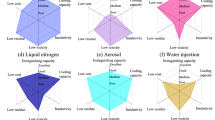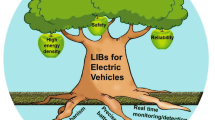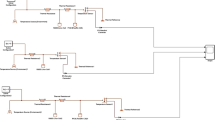Abstract
Due to environmental concerns regarding the use of mineral oil, biodegradable oil is increasingly being used as an alternative dielectric fluid. This paper presents results of experiments performed in the laboratory on the use of biodegradable oils for transformer application. The investigations cover two important diagnostic techniques for insulation assessment: (i) an investigation of partial discharge (PD) activity and characteristics in such oils and (ii) an investigation of the standard hydrocarbon dissolved gas products produced due to transformer faults. The fundamental aim of the investigation was to provide information as to whether the existing analysis techniques of PD fault pattern recognition and dissolved gas analysis methods, developed for mineral oil, are valid when used for insulation assessment with biodegradable transformer oil. The experiments were conducted on test samples to simulate three common types of transformer faults: low-energy PDs, high-energy arcing/sparking, and overheating. For the purpose of comparison, the same tests were performed using a mineral oil (Shell Diala MX) and a biodegradable oil (Envirotemp FR3). Also, each oil type was tested at three different moisture levels and with or without the presence of solid insulating materials (pressboard). PD activity was monitored using the standard IEC60270 phase-resolved analysis method. The fault gases produced were extracted and analysed by standard gas chromatography methods. Test results indicate that the PD phase resolved patterns are, in general, similar for the two oil types and thus existing PD pattern interpretations can be used to distinguish different types of PD faults, e.g. corona versus surface discharges. However, the values of various discharge quantities (PD magnitudes, repetition rate, current, etc) are very different under the same test condition. The quantities and the trend of dissolved gases for faults in biodegradable oil are substantially different compared with mineral oil. For the PD fault, biodegradable oil was found to release only a limited number of gases. For arcing and overheating faults, the main key gas produced is different between the two oils. Also, the presence of cellulosic materials such as pressboard influences the extent of hydrocarbon gases dissolved in the oil. It was found that for biodegradable oil, fewer amounts of gases are produced as the oil gets wetter.
Similar content being viewed by others

References
Oommen TV (2002) Vegetable oils for liquid-filled transformers. IEEE Electr Insul Mag 18(1): 6–11
Blackburn TR, Budin K, Finlay B, Islam S, McPherson L (2006) Australian experience with the development, ageing and maintenance of vegetable-based insulating oils. CIGRÉ Paris Session, Paper D1-301
Imamovic D, Lai KX, Muhamad NA, Phung BT, Blackburn TR (2007) Partial discharge and dissolved gas analysis studies in bio-degradable transformer oil. CIGRÉ SC A2&D1 Colloquium, Bruges, Belgium 2007, 7–12 October 2007, paper PS1-06
Lai KX, Phung BT, Blackburn TR, Muhamad NA (2007) Comparison of partial discharge activity in mineral oil and in bio-degradable oil. In: Australasian Universities power engineering conference (AUPEC’07), 9–12 Dec 2007, Perth, Australia, pp 217–222
Muhamad NA, Phung BT, Blackburn TR (2008) Dissolved gas analysis of transformer faults in biodegradable oil. In: 4th IASTED Asian conference on power and energy systems (AsiaPES 2008), 2–4 April 2008, Langkawi Malaysia
Muhamad NA, Phung BT, Blackburn TR, Lai KX (2008) Dissolved gas analysis of faults in bio-degradable oil transformer insulating systems. In: International conference on condition monitoring and diagnosis (CMD), 21–24 April 2008, Beijing, China, paper G-8, pp 663–666
Muhamad NA, Phung BT and Blackburn TR (2008) Dissolved gas analysis (DGA) of arcing faults in biodegradable oil insulation systems. In: International symposium on electrical insulating materials (ISEIM), 7–11 Sep 2008, Yokkaichi, Japan, pp 24–27
Muhamad NA, Phung BT, Blackburn TR (2008) Dissolved gas analysis (DGA) study of overheating faults in bio-degradable oil insulating systems. In: Australasian Universities power engineering conference (AUPEC 2008), 14–17 Dec 2008, Sydney, Australia, Paper 179
Muhamad NA (2009) Condition monitoring of biodegradable oil-filled transformers using DGA, PD and PDC measurement techniques. PhD thesis, University of NSW, Australia
Imad-U-Khan , Wang Z, Cotton I, Northcote S (2007) Dissolved gas analysis of alternative fluids for power transformers. IEEE Electr Insul Mag 23(5): 5–14
Duval M (2008) The Duval triangle for load tap changers, non-mineral and low temperature faults in transformer. IEEE Electr Insul Mag 24: 22–29
Rapp KJ, McShane CP, Luksich J (2005) Interaction mechanisms of natural ester dielectric fluid and Kraft paper. In: IEEE international conference on dielectric liquids, pp 393–396
Author information
Authors and Affiliations
Corresponding author
Rights and permissions
About this article
Cite this article
Muhamad, N.A., Phung, B.T. & Blackburn, T.R. Application of common transformers faults diagnosis methods on biodegradable oil-filled transformers. Electr Eng 94, 207–216 (2012). https://doi.org/10.1007/s00202-012-0232-z
Received:
Accepted:
Published:
Issue Date:
DOI: https://doi.org/10.1007/s00202-012-0232-z



